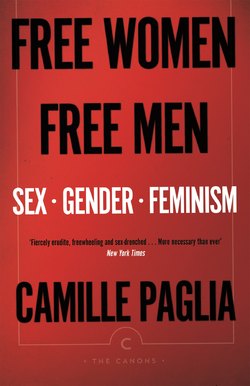Читать книгу Free Women, Free Men - Camille Paglia - Страница 11
Оглавление2
THE VENUS OF WILLENDORF
Our first exhibit from Western art is the so-called Venus of Willendorf, a tiny statuette (height 4⅜") from the Old Stone Age found in Austria. In it we see all the strange laws of primitive earth-cult. Woman is idol and object, goddess and prisoner. She is buried in the bulging mass of her own fecund body.
The Venus of Willendorf is comically named, for she is unbeautiful by every standard. But beauty has not yet emerged as a criterion for art. In the Old Stone Age, art is magic, a ritual re-creation of what-is-desired. Cave paintings were not meant to be seen. Their beauty for us is incidental. Bison and reindeer crowd the walls, following rock ridges and grooves. Art was invocation, a summoning: mother nature, let herds return that man might eat. Caves were the bowels of the goddess, and art was a sexual scribbling, an impregnation. It had rhythm and vitality but no visual status. The Venus of Willendorf, a cult-image half-molded from a rough stone, is unbeautiful because art has not yet found its relation to the eye. Her fat is a symbol of abundance in an age of famine. She is the too-muchness of nature, which man longs to direct to his salvation.
[Sexual Personae, 1990, Chapter 2, “The Birth of the Western Eye”]
Venus of Willendorf carries her cave with her. She is blind, masked. Her ropes of corn-row hair look forward to the invention of agriculture. She has a furrowed brow. Her facelessness is the impersonality of primitive sex and religion. There is no psychology or identity yet, because there is no society, no cohesion. Men cower and scatter at the blast of the elements. Venus of Willendorf is eyeless because nature can be seen but not known. She is remote even as she kills and creates. The statuette, so overflowing and protuberant, is ritually invisible. She stifles the eye. She is the cloud of archaic night.
Venus of Willendorf, ca. 30,000 B.C. (Bridgeman-Giraudon/Art Resource, N.Y.)
Bulging, bulbous, bubbling. Venus of Willendorf, bent over her own belly, tends the hot pot of nature. She is eternally pregnant. She broods, in all senses. She is hen, nest, egg. The Latin mater and materia, mother and matter, are etymologically connected. Venus of Willendorf is the nature-mother as primeval muck, oozing into infant forms. She is female but not feminine. She is turgid with primal force, swollen with great expectations. She has no feet. Placed on end, she would topple over. Woman is immobile, weighed down by her inflated mounds of breast, belly, and buttock. Like Venus de Milo, Venus of Willendorf has no arms. They are flat flippers scratched on the stone, unevolved, useless. She has no thumbs and therefore no tools. Unlike man, she can neither roam nor build. She is a mountain that can be climbed but can never move.
Venus is a solipsist, navel-gazing. Femaleness is self-referential and self-replicating. Delphi was called the omphalos or navel of the world, marked by a shapeless holy stone. A black meteorite, a primitive image of Cybele, was brought to Rome from Phrygia to save the city in the last Punic War. The Palladium, a Zeus-sent image of Athena upon which Troy’s fate depended, was probably such a meteorite. Today, the Kaaba, the inner sanctuary of the Great Mosque of Mecca, enshrines a meteorite, the Black Stone, as the holiest relic of Islam. The Venus of Willendorf is a kind of meteorite, a quirky found object, lumpish and mystic. The Delphic omphalos-stone was cone, womb, and beehive. The braided cap of Venus of Willendorf is hive-like—prefiguring the provocative beehives of French court wigs and shellacked swinging-Sixties towers. Venus buzzes to herself, queen for all days, woman for all seasons. She sleeps. She is hibernation and harvest, the turning wheel of the year. The egg-shaped Venus thinks in circles. Mind under matter.
Sex, I said, is a descent to the nether realms, a daily sinking from sky-cult to earth-cult. It is abdominal, abominable, daemonic. Venus of Willendorf is going down, disappearing into her own labyrinth. She is a tuber, rooted from a pocket of earth. Kenneth Clark divides female nudes into the Vegetable and the Crystalline Aphrodite. Inert and self-communing, Venus of Willendorf represents the obstacle of sex and vegetable nature. It is at her shrine that we worship in oral sex. In the bowels of the earth mother, we feel but do not think or see. Venus dwindles to a double pubic delta, knees clamped and cramped in the sharp pelvic angle of the wide-hipped child-bearing woman, which prevents her from running with ease. Female jiggle is the duck-like waddle of our wallowing Willendorf, who swims in the underground river of liquid nature. Sex is probings, plumbing, secretions, gushings. Venus is drowsing and dowsing, hearkening to the stirring in her sac of waters.
Is the Venus of Willendorf just to female experience? Yes. Woman is trapped in her wavy, watery body. She must listen and learn from something beyond and yet within her. The Venus of Willendorf, blind, tongueless, brainless, armless, knock-kneed, seems a depressing model of gender. Yet woman is depressed, pressed down, by earth’s gravitation, calling us back to her bosom. We will see that malign magnetism at work in Michelangelo, one of his great themes and obsessions. In the West, art is a hacking away at nature’s excess. The Western mind makes definitions. That is, it draws lines. This is the heart of Apollonianism. There are no lines in the Venus of Willendorf, only curves and circles. She is the formlessness of nature. She is mired in the miasmic swamp I identify with Dionysus. Life always begins and ends in squalor. The Venus of Willendorf, slumping, slovenly, sluttish, is in a rut, the womb-tomb of mother nature. Never send to know for whom the belle tolls. She tolls for thee.
